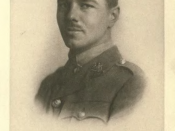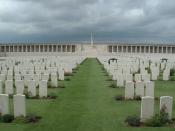The title "Dulce Et Decorum Est", translates to "It is sweet and honourable". The title itself is ironic as it is referring to the horrors of war.
Wilfred Owen was one of the great anti-war poets. He was killed on the battlefield just a mere one week before World War I ended. His poetry illustrates the horrors of war gained through firsthand experience. Owen's poem, Dulce et Decorum Est depicts a dreamlike setting and haunting images that provide a vivid picture of the realities of
warfare. The poet criticizes the concept that it is sweet, honourable and patriotic to fight and die for one's country. He portrays this criticism, throughout the poem, using a combination of many poetic devices.
The rhyming scheme of Dulce Et Decorum Est is ABAB, CDCD. There are sudden mood changes that occur throughout the poem. The most effective transition is from the first to the second stanza.
In the first stanza the soldiers are slowly walking along, tired, and hurt. In the second stanza, a sudden gas attack occurs and action begins to take place. Owens' creative use of figurative language produces harsh images, relating to the brutalities of war. One of the most important aspects of the poem is its graphic imagery. This contributes to the effect of the poem and allows the reader to see the gruesome and disturbing images of war. The reader's attention does not wander throughout the poem because of Owen's consistent imagery. It is this attention to form and imagery that make this poem thoroughly effective with the mood and tension. Imagery has an overwhelming effect on the meaning of the poem, but so does its structure. Each line has a fair length to it, creating a slow rhythm relative to the overall mood of the poem,


